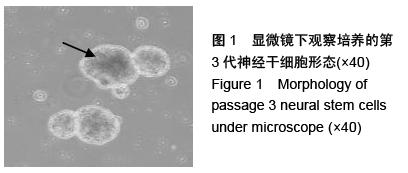| [1] 武俏丽,李庆国,梁建伟,等.K506促进神经干细胞移植后损伤脊髓神经传导通路的修复[J].中华创伤杂志, 2011, 27(3):245-248.
[2] 邢琪,宋飞,魏明海,等.同种异体胚胎神经干细胞移植修复脊髓损伤的时效性[J].中国组织工程研究与临床康复, 2008,12(21):4189-4192.
[3] Nemati SN, Jabbari R, Hajinasrollah M, et al. Transplantation of adult monkey neural stem cells into a contusion spinal cord injury model in rhesus macaque monkeys. Cell J. 2014;16(2):117-130.
[4] 杨金伟,杨慧娟,殷露玮,等.神经干细胞与嗅鞘细胞移植对脊髓全横断大鼠后肢运动功能的影响[J].昆明医学院学报, 2007,28(6):19-23.
[5] 武俏丽,唐帆,李庆国,等.神经干细胞移植联合FK506对脊髓损伤病理和超微结构变化的影响[J].中华创伤杂志, 2012,28(8):748-753.
[6] Lee Y, Lee S, Lee SR, et al. Beneficial effects of melatonin combined with exercise on endogenous neural stem/progenitor cells proliferation after spinal cord injury. Int J Mol Sci. 2014;15(2):2207-2222.
[7] 李萌,陈银海,张慧,等.早期运动训练对脊髓损伤大鼠后肢运动功能影响及相关机制研究[J].中国康复医学杂志, 2015,30(4):318-323.
[8] 宋飞,邢琪,魏明海,等.同种异体胚胎神经干细胞移植修复脊髓损伤的时效性观察[J].中国组织工程研究与临床康复,2007,11(11):2091-2093,2097.
[9] Gericota B, Anderson JS, Mitchell G, et al. Canine epidermal neural crest stem cells: characterization and potential as therapy candidate for a large animal model of spinal cord injury. Stem Cells Transl Med. 2014;3(3): 334-345.
[10] 赵岩,肖宇龙,左媛,等.神经干细胞移植联合促红细胞生成素对大鼠脊髓损伤的修复作用[J].吉林大学学报:医学版, 2015,41(2):333-337.
[11] 王喜良,赵岩,左媛,等.神经干细胞移植联合腹腔注射促红细胞生成素对横断性脊髓损伤大鼠神经轴突的修复作用[J].吉林大学学报:医学版,2015,41(1):99-104.
[12] 马延超,董海涛,王翠芳,等.外源性音猥因子对成年大鼠脊髓损伤后室管膜区神经干细胞增殖的影响[J].中华创伤杂志,2014,30(7):740-743.
[13] 李葛威,吴成如,方健,等.富氢生理盐水对兔脊髓损伤神经细胞凋亡及凋亡相关蛋白表达的影响[J].颈腰痛杂志, 2015,36(3):197-200.
[14] Iwasaki M, Wilcox JT, Nishimura Y, et al. Synergistic effects of self-assembling peptide and neural stem/progenitor cells to promote tissue repair and forelimb functional recovery in cervical spinal cord injury. Biomaterials. 2014;35(9):2617-2629.
[15] 胡杰亮,康学文,汪静,等.携带神经干细胞的肌基膜管在大鼠脊髓损伤修复中的应用[J].中华创伤杂志, 2014,30(1): 73-77.
[16] 张海滨,王春芳,李鹏飞,等.小鼠脊髓损伤模型的建立及神经干细胞移植后运动功能恢复情况的研究[J].中国组织化学与细胞化学杂志,2014,23(2):105-110.
[17] 刘燕青,赵启军,何羽强,等. 嗅鞘细胞联合神经干细胞对大鼠急性脊髓损伤及神经营养素-3表达的影响[J].中国医学创新,2014,11(22): 24-30.
[18] Oh JS, Ha Y, An SS, et al. Hypoxia-preconditioned adipose tissue-derived mesenchymal stem cell increase the survival and gene expression of engineered neural stem cells in a spinal cord injury model. Neurosci Lett. 2010;472(3):215-219.
[19] Li Z, Zhao W, Liu W, et al. Transplantation of placenta-derived mesenchymal stem cell-induced neural stem cells to treat spinal cord injury. Neural Regen Res. 2014;9(24):2197-2204.
[20] 金华,赵强,张昆林,等. 神经干细胞动脉移植治疗脊髓损伤后Bcl-2与Bax的变化[J].中风与神经疾病杂志, 2014, 31(8):691-694.
[21] 曹雅娜,王红星,王彤,等. A型肉毒毒素注射联合运动训练对脊髓损伤大鼠运动功能及腓肠肌功能的影响[J].中华物理医学与康复杂志,2014,36(12):902-906.
[22] 柴湘婷,王红星,丁晓晶,等.运动训练对大鼠损伤远端脊髓超微结构及脑源性神经营养因子表达的影响[J].中国康复医学杂志,2012,27(8): 728-731.
[23] 潘孟骁,王红星,丁晓晶,等.运动训练对大鼠损伤远端脊髓及骨骼肌血管内皮生长因子表达的影响[J].中国康复医学杂志,2012,27(5): 406-409.
[24] Amemori T, Romanyuk N, Jendelova P, et al. Human conditionally immortalized neural stem cells improve locomotor function after spinal cord injury in the rat. Stem Cell Res Ther. 2013;4(3):68.
[25] Zhou QZ, Zhang G, Long HB, et al. Effect of spinal cord extracts after spinal cord injury on proliferation of rat embryonic neural stem cells and Notch signal pathway in vitro. Asian Pac J Trop Med. 2014;7(7):562-567.
[26] 丁晓晶,王瑾,王红星,等.不同训练方式对脊髓损伤大鼠运动功能及神经肌肉形态学的影响[J].中华物理医学与康复杂志,2011,33(10):725-730.
[27] 周治来,陈银海,靳安民,等.运动训练对脊髓损伤大鼠Nogo-A、NgR mRNA表达的影响[J].中国康复医学杂志,2011,26(2):143-147.
[28] 徐冬晨,王红星,雷晓婷,等.运动训练对脊髓损伤大鼠运动及神经功能恢复的影响[J].中华物理医学与康复杂志, 2010,32(1): 9-12.
[29] 贺晓玉.运动训练对脊髓损伤大鼠脊髓内BDNF及其受体TrkB表达的影响[J].天津医药,2014,42(6):547-550.
[30] Stenudd M, Sabelström H, Frisén J. Role of endogenous neural stem cells in spinal cord injury and repair. JAMA Neurol. 2015;72(2):235-237.
[31] 贺晓玉,周嘉嘉,邓京捷,等.运动训练对脊髓损伤大鼠脊髓内神经生长因子及其受体TrkA表达的影响[J].海南医学, 2014,25(11):1563-1566.
[32] 肖寒贫,顾兵,王烁宇,等.运动训练对脊髓损伤大鼠康复作用的研究现状[J].神经损伤与功能重建,2013,8(3): 221-224.
[33] Molazem Z, Falahati T, Jahanbin I, et al. The effect of psycho-educational interventions on the quality of life of the family caregivers of the patients with spinal cord injury: a randomized controlled trial. Int J Community Based Nurs Midwifery. 2014;2(1):31-39.
[34] de Andrade LT, de Araújo EG, Andrade Kda R, et al. Autonomic dysreflexia and nursing interventions for patients with spinal cord injury. Rev Esc Enferm USP. 2013;47(1):93-100.
[35] 李哲,王国胜,郭钢花,等.神经干细胞移植对脊髓损伤大鼠血管生成的影响[J].中华物理医学与康复杂志,2014, 36(7): 497-502.
[36] 丁晓晶,王红星,王彤.脊髓损伤大鼠运动训练方式的研究进展[J].中国康复医学杂志,2010,25(6):589-591.
[37] Iwai H, Nori S, Nishimura S, et al. Transplantation of neural stem/progenitor cells at different locations in mice with spinal cord injury. Cell Transplant. 2014; 23(11):1451-1464.
[38] 张鑫,李萌,陈银海,等.hADSCs移植联合运动训练对脊髓损伤大鼠运动功能的影响及其相关机制[J].中华神经医学杂志,2014,13(5): 472-477.
[39] Wang D, Liang J, Zhang J, et al. Mild hypothermia combined with a scaffold of NgR-silenced neural stem cells/Schwann cells to treat spinal cord injury. Neural Regen Res. 2014;9(24):2189-2196.
[40] 李哲,郭钢花,王国胜,等.基质细胞衍生因子-1对神经干细胞移植治疗脊髓损伤大鼠疗效的影响[J].中华物理医学与康复杂志,2015,37(6):411-415.
|
.jpg)


.jpg)
.jpg)
.jpg)


.jpg)